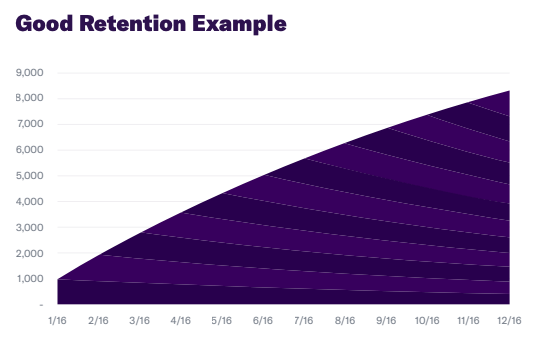Why Retention Matters
The following is an excerpt from our eBook, “The Heap Guide to Retention.” You can download the entire eBook here.
Building a product-driven business takes energy. There’s marketing to generate interest, and a sales apparatus to bring deals home. On the product side, there’s the initial user experience to develop, and the value your product should demonstrate from the get go.
These activities are all important for getting customers in the door. But once people start using your product, it’s your retention strategy that keeps them there. Plenty of users are willing to try a product once or twice. But if your product or feature doesn’t provide ongoing value over time, or is too difficult to use, or if the pains your product addresses can be more easily solved by a competitor, those users won’t stick around.
In fact, from a product perspective, it’s not unreasonable to say that retention is the best measure of product-market fit. For the bulk of digital products—websites, mobile apps, business platforms, and many more— achieving product-market fit means producing a product that users willingly return to.
Learn how Product-Market Fit works here!
It’s for these reasons that Product Managers should be somewhat obsessed with retention: measuring it, understanding it, developing their product or features with an eye towards improving it.
Other growth metrics matter too, of course. Acquisition numbers tell you how well you’re able to sell your product to customers who haven’t used it yet. Activation numbers tell you how many people you can get into your product. Retention alone tells you if customers are finding ongoing value in your product.
10 Winning Retention Strategies
The Business Case for Retention
Another way to think about retention is to measure business impact. Most of us know that it’s far more expensive to acquire a new customer than to retain a current one—anywhere from 5 to 25 times more expensive. From the business’ perspective, a poor retention strategy puts unnecessary pressure on your acquisition efforts—marketing and sales.
The diagram below gives a quick explanation. To the question, “would you be happy with a monthly retention rate of 95%?” most product companies tend to answer yes. (When we ask this question in presentations, the majority of the audience raises its hand.)

Yet the numbers at the bottom of the chart display the compounding effect of a 5% churn rate. Simply losing 5% of your users a month means a yearly churn rate of 43%.
This 43% doesn’t only mean a loss of income (via diminished subscription costs, ad sales, renewals, or whatever business model your company supports). It also holds back growth, since you need to grow by 43% per year to simply maintain a constant number of users.
You can see how increasing or decreasing retention by even a single percent has on your yearly revenue. Simply decreasing retention rates to 4% gives you an increase of seven customers a year. These seven customers translate to meaningful business value. As a product manager, you partner with marketing and sales to entice customers to your product. But you also have special insight into what makes them stay.
What is Customer Retention? Read more in our complete guide!
Down the funnel and back
One can also think about retention as the gift that keeps on giving. Much of what happens further along the customer journey depends on how well you’re retaining your customers. Renewals, expansions, referrals, recommendations: all only happen when your customers continue to find value in your product.
Let’s think a little bigger. For each individual customer, retention is key for moving them down the path. For your company as a whole, however retention plays an outsized role on acquisition and activation. Why? Because retained customers give you proof points, case studies, and other documentable evidence that your product works. Showing a market that you can provide ongoing value to customers is the easiest way to get prospects excited about what you can do for them.
The effects extend outwards. Demonstrate stickiness and you’ll find partners more interested in working with you. Retain well known customers and word spreads. Having a stable of satisfied customers to call on gives salespeople a critical tool for their arsenal. And so on.
In fact, we could say that for most product-based companies, retention is the primary objective for sustaining growth.
Read our guide to Customer Churn.
Good vs. bad retention graphs
Below you can see the difference between an effective and a non-effective retention strategy. The graph reflects a user base with a strong initial period of acquisition and activation, then a long-term flattening out, indicating high churn and (assuming the company is putting effort into bringing in new users) poor long-term retention.
Bad Retention Example
Bad Retention Example

If you’re at the early stages of this graph, your growth rates may be encouraging. But they can also be misleading, since they don’t tell you how many of your new customers are going to stay.
If you’re regularly measuring retention and are observing a graph that looks like this, it should be cause for alarm.
Below you can see what a user graph looks like when a company has a good retention strategy in place. In this case the number of users continues to increase over time, ensuring that your company’s ability to retain users matches its ability to acquire them.
Good Retention Example
Good Retention Example

Three Stages of Retention
The graph below—whose shape is typical for many companies—shows the standard way we measure retention. The initial number—62%—represents the number of acquired users who actually engage with your product.
Typically this number drops significantly after a short period of time, here a month, and levels off into a more standard user rate. That number is generally what you’ll use as your baseline as you run experiments designed to increase retention rates.
Three Stages of Retention
Three Stages of Retention

This number can also be helpful for forecasting revenue. If you know that 16% of acquired users are likely to keep using your product and you have a decent idea of how long they’ll stick around, you can produce a useful forecasting model.
In this graph, you also see how user numbers slowly decrease over the course of the year, indicating slow but steady churn. The final significant drop occurs at the end of the year, when the large majority of users still in the product or using the feature drop off entirely.
As a Product Manager, it’s your job to know the retention rates at each of these stages—initial use, longer sustained period of time, and a larger drop off at the end—and to develop hypotheses around improving them.
Interested in learning more about how to improve retention in your business? Download “The Heap Guide to Retention” to learn why retention is the metric that best measures product value, the hypotheses and experiments that drive impact for different stages of retention, and how Product Managers can better plan their roadmaps to increase retention.

